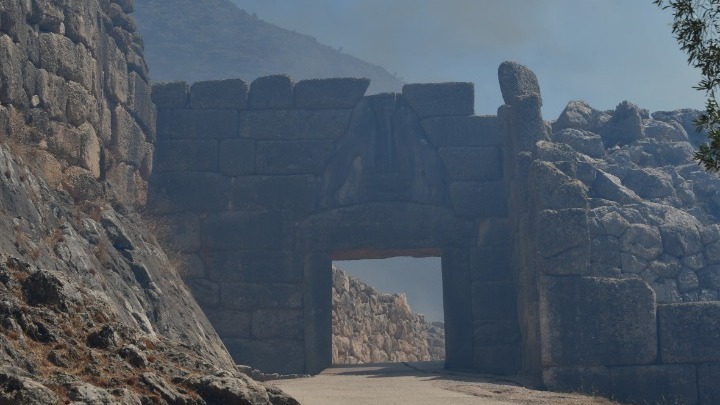The Lion Gate, the iconic stone archway that serves as the main entrance of the citadel of Mycenae in the Peloponnese, has not been damaged by the wildfire that broke out on Sunday, and there is no damage to the archaeological site, according to Culture Minister Lina Mendoni, who visited the area on Monday.
Speaking to interviewers from Thema 104.6 Radio, shortly after she visited the Mycenae archaeological site to assess any possible problems caused by the fire, the Greek minister said that the blaze thankfully did not cause any actual damage.
“The fire had the least possible effect at the archeological site, as there were preventive measures taken and the response was immediate,” Mendoni stated.
“Since deforestation works had taken place, there was no grass to act as fuel and increase the fire. This had the effect of burning a hole but not creating thermal loads that would have caused damage to the structural elements of the monuments,” the Culture Minister explained.
“The fire did not reach the Lion Gate, did not reach the entrance of Atrea, did not affect the burial circle. The monuments themselves have not suffered any damage. There are only islets with burnt grass less than 1 cm high and some stones have turned black,” Mendoni stated.
Criticism
However, some social media users say that Mendoni is playing down the effect of the wildfire on Mycenae. Some photographs clearly show that the Lion Gate has been blackened by the fire.
Main opposition SYRIZA sternly criticized Culture Minister on her statements on the wildfire at Mycenae.
“(Culture Minister Lina) Mendoni sees just a little black on the soil,” said SYRIZA “when the international public opinion and the Greek society saw yesterday an incalculable tragedy that burned Mycenae, one of the most emblematic archaeological sites of Greece”.
SYRIZA underlined that the picture exposes the minister over her audacity and immodesty adding that “the least someone would expect from her is to apologise to the Greek people”.
According to the Ministry of Culture, the site will re-open on Tuesday.
The Lion Gate
The Lion Gate served as the main entrance of the Bronze Age citadel of Mycenae, erected in approximately 1250 BC on the northwest side of the acropolis. It takes its name from the sculptures of two lions which stand above the entrance.
The Lion Gate is remarkable for being the only surviving monumental piece of Mycenaean sculpture, and the largest sculpture in all of the prehistoric Aegean. It is the only monument of Bronze Age Greece to bear an iconographic motif that survived without being buried underground, and the only relief image which was described in the literature of classical antiquity.
The greater part of the Cyclopean wall in Mycenae was built during the second extension of the citadel, which took place in the 13th century BC. The grave circle was found east of the Lion Gate, where a peribolos wall had also been built.
After the expansion, one could enter Mycenae by two gates, a main entrance and a postern, while the most extensive feature was the remodeling of the Lion Gate, the main entrance to the citadel, in the northwestern side, which was built circa 1250 BC.
The Lion Gate was approached by a partially-engineered ramp which is oriented on a northwest-southeast axis. The eastern side of the approach, which is flanked by the steep, smooth slope of the earlier enceinte, was embellished with a new facade.
On the western side a rectangular bastion was constructed, measuring 14.80 meters (49 feet) long and 7.23 meters (24 feet) wide, built of enormous conglomerate blocks. The structure was termed “Cyclopean” since it appeared that the ancient buildings could have been built by the legendary giants whose culture was presumed to have preceded that of the Classical Greeks, as described in their myths.
Between the wall and the bastion, the approach narrows to a small open courtyard measuring 15 meters × 7.23 meters (49 feet × 24 feet), whose rather diminutive size was likely designed as a way to limit the numbers of attackers on the gate.
The bastion on the right side of the gate served as a defense from the attackers’ right flank, which would normally be vulnerable as they would carry their shields on their left sides.
At the end of the approach stands the Lion Gate, which is an extraordinarily imposing stone structure, standing 3.10 meters (10 feet) wide and 2.95 meters (10 feet) high at the threshold. It narrows as it rises, measuring 2.78 meters (9 feet) below the lintel. The opening was once closed by a double door.
The gate itself consists of two great monoliths capped with a huge lintel measuring 4.5 X 2 X 0.8 meters (15×7×3 feet). Above the lintel, the masonry forms a corbelled arch, leaving an opening that lightens the weight carried by the lintel. This relieving triangle is a great limestone slab on which two lionesses or lions carved in high relief stand on either side of a central pillar. The heads of the animals are unfortunately missing, save for their necks.
The pillar is a Minoan-type column that is placed on top of an altar-like platform upon which the lionesses rest their front feet.
(Source: Wikipedia)
See all the latest news from Greece and the world at Greekreporter.com. Contact our newsroom to report an update or send your story, photos and videos. Follow GR on Google News and subscribe here to our daily email!





